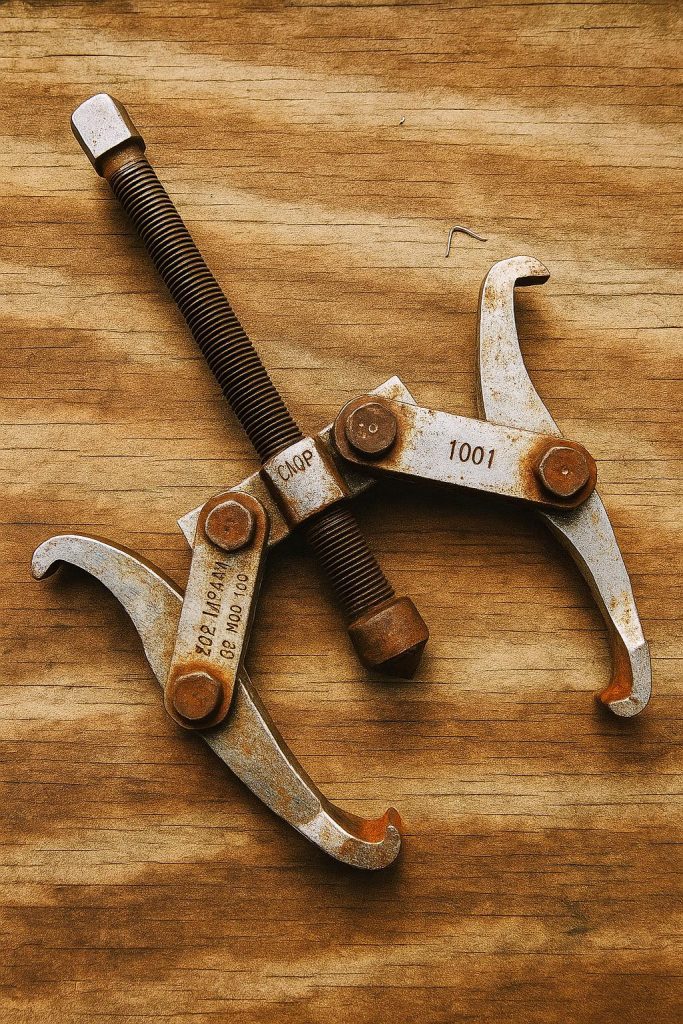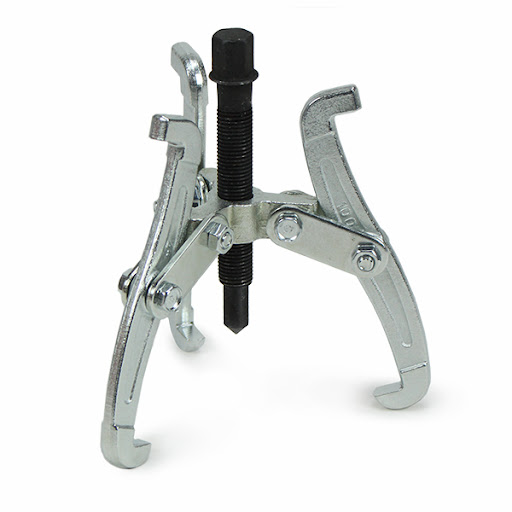The Forgotten Tool: When Craftsmanship Meant Forever
There was a time when tools were more than just pieces of metal. They were companions of craftsmen — reliable, enduring, and built to last a lifetime. Look closely at this object in the image — those curved arms, the central threaded bolt, the weathered steel aged by years of use. If it feels familiar, congratulations: you belong to an era when precision was earned, not programmed.
The Timeless Power of Simplicity
This is a pulley puller, sometimes called a gear puller or bearing puller. It’s not flashy, not digital, and doesn’t need batteries. Yet, its genius lies in simplicity — a design so efficient that even decades later, it’s still irreplaceable. Mechanics once used this tool to remove pulleys, gears, and bearings from shafts with delicate precision. No shortcuts, no guesswork, just the strength of steel and the steady twist of a wrench.

A Glimpse Into the Age of Real Work
Back then, workshops smelled of oil, sweat, and determination. The rhythmic clank of metal on metal was a kind of music. A tool like this was an extension of a worker’s hand — strong, steady, and patient. Each thread of the screw, each curve of the arm, was shaped by human intention, not mass production.
Modern tools might boast of speed and convenience, but they rarely carry a soul. This old puller, though rusted and worn, whispers of an age where reliability was everything. When a man’s worth wasn’t measured by brand names, but by how well he could fix what was broken.
Understanding the Design: The Art of Function
Every line in this puller serves a purpose.
- The central screw delivers the pulling force — turning it slowly draws the attached jaws closer, gripping tight around the gear or pulley.
- The two arms (jaws) are the heart of the tool, designed to apply even pressure so nothing cracks or bends under strain.
- The crossbar and bolts align it all, ensuring that motion becomes power.
It’s mechanical poetry — balance, force, and precision working in harmony. Like a blacksmith’s song, it’s the sound of mastery meeting purpose.
Video : MAKE A DIY BEARING PULLER // PULLEY PULLER // GEAR PULLER
Why It Still Matters Today
In a throwaway world of plastic and planned obsolescence, tools like this are quiet reminders of what quality once meant. They don’t just work; they endure. Many of these old pullers, made from forged carbon steel or cast iron, still operate flawlessly after decades. No batteries to die, no circuit boards to fail — just raw engineering that defies time.
Some may see it as outdated. But for those who’ve turned its screw and felt its weight, it’s a symbol of trust. It represents an unspoken promise: if you take care of it, it will take care of you.
From Machine Shops to Memory
These pullers once lived in machine shops, auto garages, and factories — tucked into tool chests beside greasy rags and well-worn hammers. They saw everything: the first engines roaring to life, broken axles being reborn, and hands that knew the meaning of hard work.
Now, many sit forgotten on dusty shelves, their metal dulled by time. But each one holds stories — of engines saved, bearings freed, and problems solved by patience and skill.
Craftsmanship as a Legacy
If you grew up seeing one of these, you’re part of a generation that understood the value of doing things right the first time. You know that good work isn’t rushed. You remember the satisfaction of hearing that final “click” when a stubborn part finally comes loose — not because you forced it, but because you understood it.

In those moments, this simple puller wasn’t just a tool; it was a teacher. It taught patience, control, and respect for the mechanics of the world.
Holding History in Your Hands
When you hold a pulley puller, you’re not just holding metal. You’re holding history — a tangible link to a world that valued skill over speed, substance over style. You can almost feel the calluses of the hands that used it before you, the quiet confidence of those who believed that craftsmanship was a calling, not just a job.
Even its rust tells a story — not of neglect, but of service. Every scar, every scratch, is proof of a life spent in honest work.
A Farewell to the Age of Iron Hands
Today’s world runs faster, shinier, and louder — but perhaps, not better. We’ve traded the puller’s patient torque for the instant hum of power tools. We’ve replaced craftsmanship with convenience. And yet, somewhere deep down, we miss the weight of real steel, the smell of grease, and the quiet pride that came from fixing something with your own hands.
So, if you recognize this tool, consider yourself lucky. You carry the memory of a time when things were built to last — when the measure of a man was in his skill, not his possessions.
Video : Bearing puller high performance utility hardware
Conclusion: More Than a Tool, a Testament
The pulley puller may look like just another piece of old machinery, but it’s far more than that. It’s a symbol of resilience, patience, and human ingenuity — a silent witness to an era when every bolt turned was an act of craftsmanship.
As it sits there, rusted yet dignified, it reminds us of something we’ve almost forgotten: that the worth of a thing — or a person — is not in how new it is, but in how well it endures.
Because in a world that’s always changing, the true strength lies not in what’s new, but in what still stands.